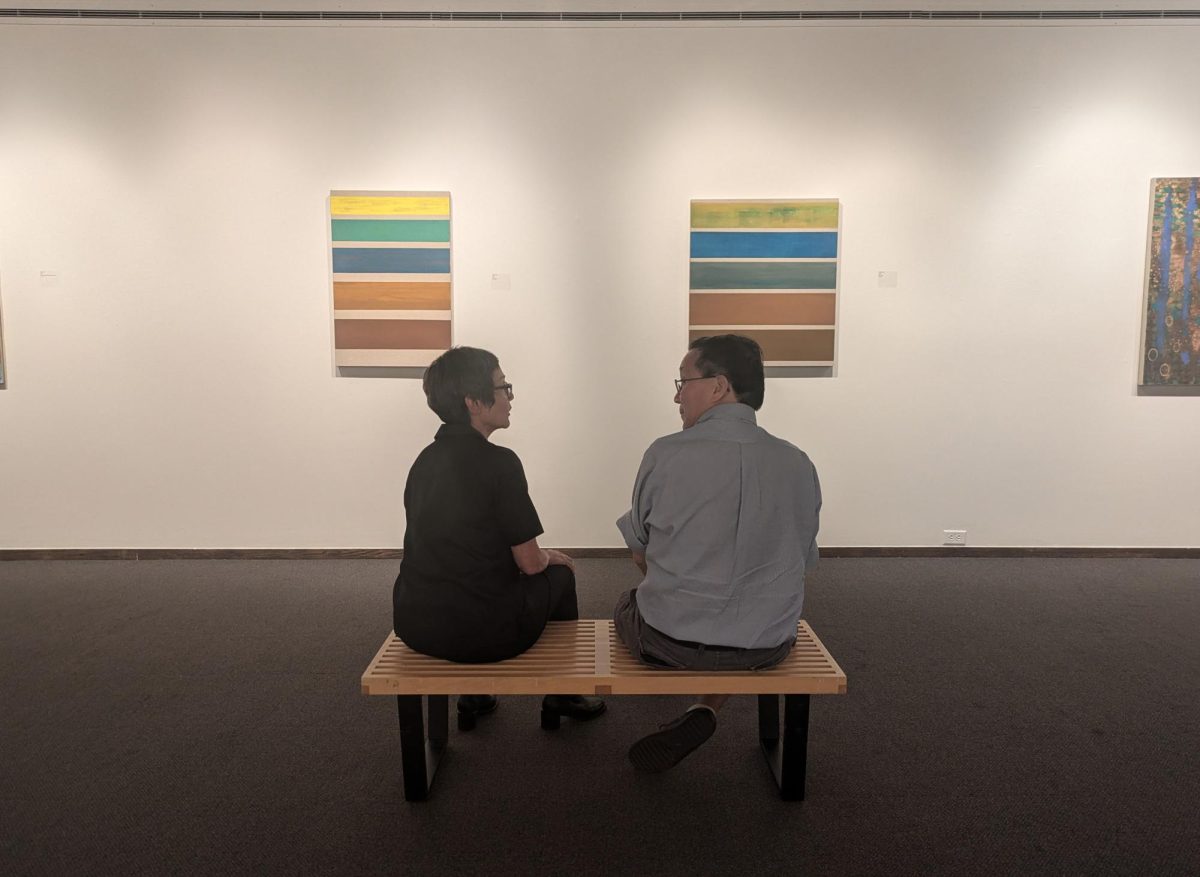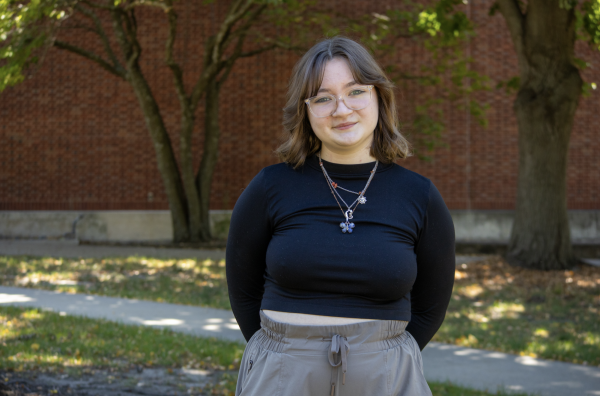The works of Ken Buhler and Kim Uchiyama, two painters who began their art journey in Iowa, were featured in “Beautiful Land,” the first Anderson Gallery exhibit of the 2024 fall semester.
The gallery opened Sept. 5 and features paintings inspired by the sensory impressions Buhler and Uchiyama experience in nature.. Both painters approached their creations in two different ways. Uchiyama’s art focuses more on line and color to portray her experience, and Buhler’s utilized color, shape and manipulation of material to depict the same message.
“The pairing of [Uchiyama’s] and [Buhler’s] work in this exhibition serves as a compelling, if almost inadvertent, exploration into this elusive aspect of ‘innateness’ as conveyed through painting,” Christina Kee, a New York-based artist and arts writer, described in the guide hand-out for the exhibit.
Those who attended the opening were quick to notice the difference between both artists’ styles.
“These two vastly different styles, one next to the other, serves as kind of a constant palette cleanser where you aren’t lulled into the familiarity of one style,” sophomore Heath Thompson said. “The style of painting that you’re looking at is constantly changing. It means that each painting that you look at you observe as though it is the first painting you’ve seen that day.”
Even though there’s a stylistic contrast between Uchiyama and Buhler, Buhler said their work is more similar than it appears.
“[Uchiyama] and I, even though our work looks very different, we both as artists are stimulated by sensory experience in the natural world,” Buhler said in an interview with the TImes-Delphic. “I like the way [Uchiyama] talks about it as a collection of sensory experiences that almost are cataloged in your subconscious memory and arise through the process of making paintings.”
Uchiyama created her work during the pandemic and showcased the passage of time. She would go on walks every morning and would observe the environment around her. She saw the seasons and weather change the longer she walked.
Her work, oil paint on linen, has several thick lines separated by varying gap sizes. No two pieces have a uniform appearance in color or thickness. Each color represents its prospective season.
“There’s a kind of slowness and syncopation,” Uchiyama said. “It’s kind of expanding and attracting time. And I think that that captured the moment, a very complex moment in my life.”
Bennett Bales, a sophomore studying graphic design, favored Uchiyama’s work to Buhler’s.
“My favorite piece so far is “Element,” which is a part of four smaller paintings that position different colors to appear unique to each other,” Bales said. “I’m more drawn to organization and spatial awareness in art.”
Uchiyama’s personal favorite painting from the collection is “Tempo Rubato,” a piece featuring five thick lines of varying sizes. Each line has its own base color with strokes of a different color layered over it. It also portrays the passage of time.
“My piano teacher from West Des Moines was at the opening, and she mentioned that it was her favorite painting in the show,” Uchiyama said. “She understood that the title meant in broken time or like erratic time. And I thought that was a great, great way to sort of tell the audience about how they could relate to the painting.”
While her work is very simplistic in contrast to Buhler’s, Uchiyama said she believes it still holds the same depth.
“I tried to make them not minimalist and maximalist in some way in terms of discretion and emotion, and I was certainly feeling very conflicted things,” Uchiyama said.
The painting Buhler most wanted to share with the Drake community in the exhibit was “Her Holy Modal Majesty,” which utilized acrylic paint and metal leaf on a canvas. The piece features blues, greens, yellows and browns layered over each other in different shapes and patterns, with gold leaf circles and ovals on top.
Buhler said he loves this piece because it “was a complete surprise” to him. When he creates, he looks to make something he doesn’t expect.
“An explorer doesn’t go to explore a world that they already know,” Buhler said. “They want to explore something they don’t know yet, something that is tied to their world, that resonates with their own, the things that are important to them. It really pushed the envelope of my vocabulary, and that’s really made me happy.”
He drew similarities between the feeling of finishing the painting to raising a child.
“It’s kind of like when you have a kid and they grow up and at a certain point, you go like, ‘Yeah, you’re actually fine on your own. You don’t need me anymore,’” Buhler said. “And that painting is like, ‘Oh, you don’t need me, do you? You’ve got your own thing going.’”
Buhler said he attributes his successful finished work to listening to his instincts.
“One of the things I always told students when I taught for many years is don’t ignore the impulses that pop into your brain, especially if they keep coming,” Buhler said.
“Beautiful Land” will remain open until Oct. 20 with a reception on Sept. 19 in the Anderson Gallery from 5 p.m. to 7 p.m.
The Times-Delphic will be publishing more in-depth coverage of the artists’ processes and inspirations in the next two issues.








